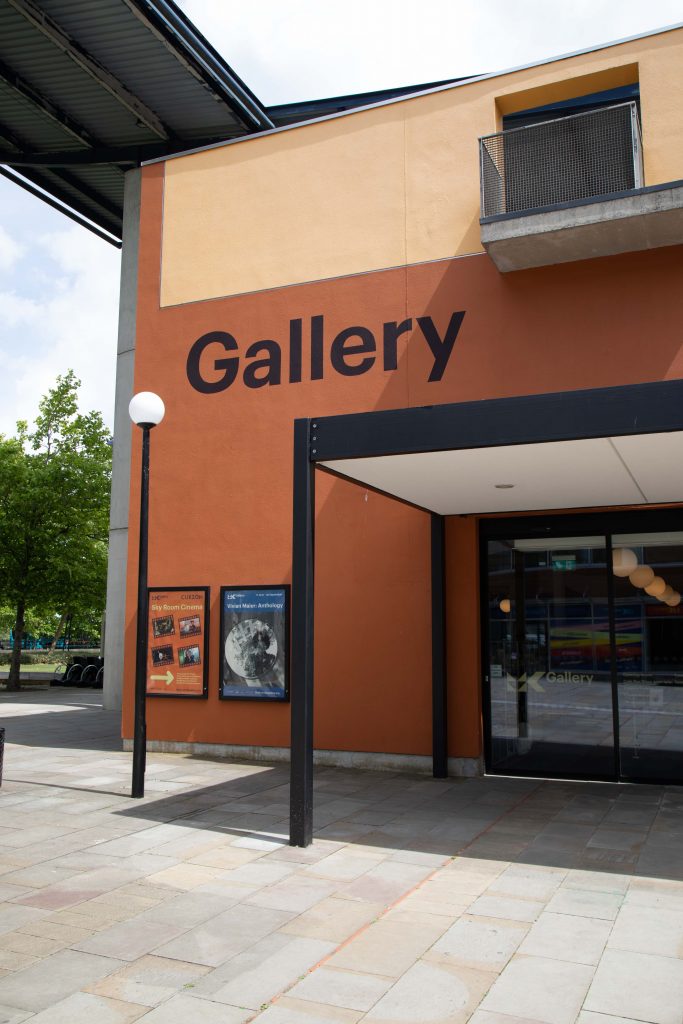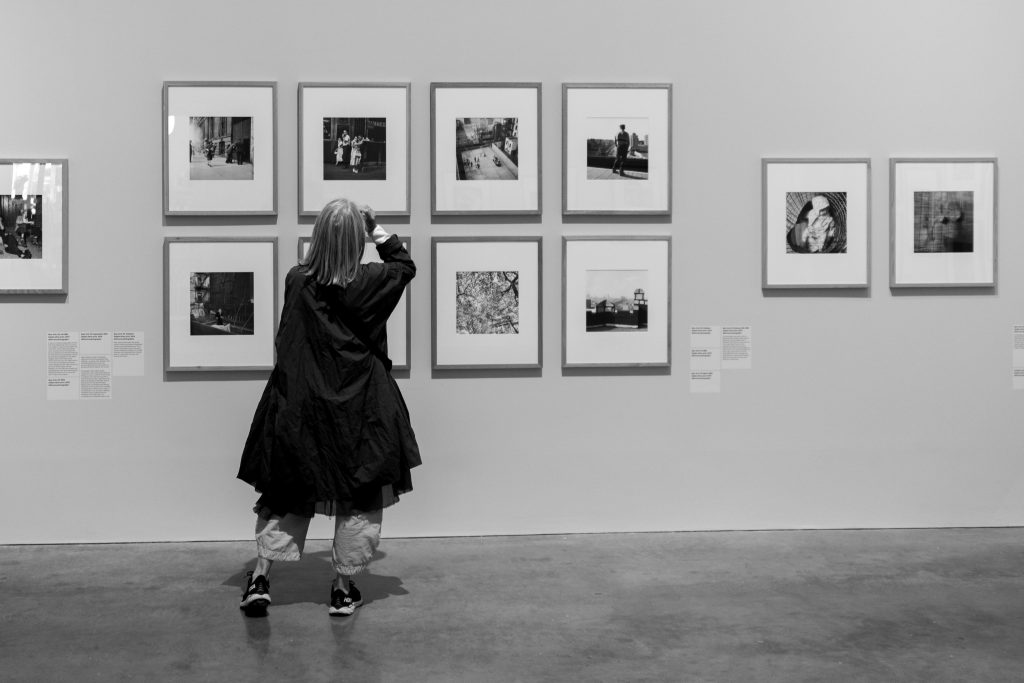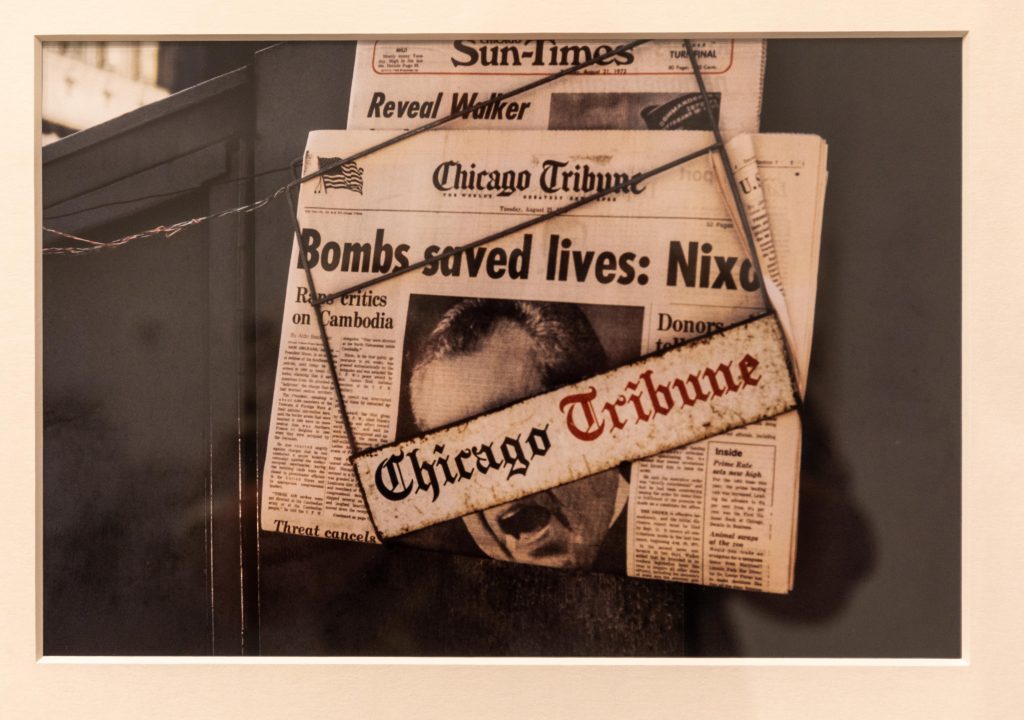On Saturday 25th June ’22 I took a drive for 100 miles to get to Milton Keynes so that I could visit the MK Gallery for an exhibition of over 140 pieces of work by Vivian Maier..
Curated by Anne Morin and produced by diChroma Photography this exhibition is open from 11th June to 25th September 2022 and is titled “Vivian Maier: Anthology”
After parking in the nearby centre:mk multi storey car park it was. a two minute walk to the gallery across the road. Unfortunately, I hadn’t checked exactly which direction I should head and wandered into the large shopping centre before regrouping and heading back out.

Entering the MK Gallery was a friendly experience with a couple of staff manning the ticket desk and after asking to see my Student Art Pass, which gives you 50% off entry, the suggested I leave my back pack in the lockers provided. With my camera gear safely stowed away in locker number 18 I went back to the gallery carrying only my Canon 5D mk IV with a 16-35 lens on.
Exhibition Layout
Upon entering the exhibition it was clear to see that there was order to the display of the images. First gallery it was black and white images all square in format printed large and mounted into light toned wooden frames. Some had explanatory labels mounted nearby and some had a sticker with very little information on. Maier it seems was a little more haphazard in the making the images with her cameras and not documenting everything for future reference. Looking at the scant knowledge we know of Maier it seems in keeping with her eccentric lifestyle.
In her lifetime she printed very few of her images, and there were hundreds of rolls of exposed films awaiting processing that have fallen into the hands of a few individuals through storage unit auctions etc so the images in this exhibit have been curated several times already, and not by the photographer herself. The estate that owns the works has already decided which images they wish to share with the public and from there the curators have further selected which fit in with their idea of the exhibition. I’m used to there being images on walls of people long since passed but there was usually an intent by the artist themselves to curate what should be seen by the general public. So to me this feels like an invasion of privacy but one that has yielded some extraordinary works.

The work was split into four overall gallery spaces , the first space full of images in a uniform fashion, mounting, framing and layout all showing earlier street photography images from Maier in the New York area where she was working as a Nanny for a family, Some of the images are obviously taken in areas that would have been considered less desirable, and in some cases she had the children with her. Most of the images were taken using a Rolleiflex Twin Lens Reflex camera at this point, and the images are taken from belt level almost like a childs eye view. As a result of holding the camera in an unobtrusive manner she was able to get very close to some subjects, where today one might end up with a broken camera or broken nose.
“Vivian’s technical skill is a thing to be admired – her crisp, clear shots and niftily constructed compositions give transparency to all manner of subjects – but it is the skill with which Vivian approaches her subjects that most resonates throughout her oeuvre. Each shot seems to have been watermarked with an unmistakable charm”
Linda Wisdom, “What we see is what we are”, analysis in exhibition,
For me this brief paragraph or two underlines a couple of things, firstly that Maier’s output of brilliantly crafted images is not beginners luck, or just a “nanny’s hobby”. It’s obviously work from incredibly skilled artist who understands composition in a masterful manner and uses it to her advantage, often in subtle ways. The fact that Maier remained a virtual unknown due to her not publishing images is entirely up to her, the fact that she didn’t sell images doesn’t mean she’s not a great photographer. Today we might consider a photographer great if their work is sold at high value in art auctions, but to me this is a secondary result of being a great photographer.. I’ve never used a twin lens reflex camera but I’m absolutely sure that it’s not an easy piece of equipment to use in order to get brilliantly focussed photos from a snapshot timescale when the image is there one second and gone the next. From people who knew Maier, they recounted that she had books about artists in her collection so she obviously was interested in furthering her own knowledge.
The second point I’d noticed is the “watermark” comment. This is true of Maier’s work and when all of her images are placed side by side like this in the gallery, a true signature seems to coagulate from the group. In my own opinion she has a style that shows sympathy and empathy whilst remaining disconnected from the subjects. The photos of a drunk being hauled into the court room seem to want to tell the story of one of society’s unfortunates but whilst she captures these images she juxtaposes it with a smartly dressed women strolling past without a care in the world or an apathy for the police and suspect. Maier catches this on the 6×6 negative to explain the real world to people who may eventually see these images.
A Child’s Point Of View
The images she made of children often pull out the extremes of society, the young children looking tatty and neglected outside the adult cinema seem a world away from the well heeled youngsters stood at their parents side in expensive boutiques. She also includes photographs of groups of children mixing together and having fun, or looking miserable. It’s as though she wants to tell their story but without making a political statement about wealth and poverty. For anyone who walked around the streets of New York and Chicago at the same time Maier was photographing the class divide, and people struggling through life would have been blatantly obvious. I don’t think Maier was trying to raise awareness of the dire situation of some of her fellow city dwellers, after all she might have published them if that were her intention.
Some of Maier’s work reminds me greatly of Helen Levitt who would have been around New York City at the same sort of time of Maier. Many of the images from both photographers contain similar thematic elements, most commonly children and people living on the poverty line.
Colourful Life
Most of the exhibition featured Black and White works but there were also some marvellous colour images that really struck a chord with me. Some of the areas that she’d photographed almost appeared black and white but there was often an item in the image that was standing out due to the colour. One image that stood out to me was a 1973 Chicago Tribune newspaper headline featuring an angry looking Richard Nixon, the US President at the time,

The print is amazing, which isn’t represented fairly by photo of it above, the colour of the “Tribune” and the outline on the SUn Times behind the Tribune is almost so subtle you don’t notice it is red.
The fact that the paper rack with the Tribune logo on it has slipped from it’s usual horizontal mount and as a result the bar goes across Nixon’s eyes at the same angle as his eye line on the face. It appears to me as though it’s covering the identity of the person, like one might have seen in pornographic magazines back in the 70s and 80s when “Readers Wives” kept people’s anonymity by placing a black bar across their eyes.
The Chicago Tribune was one of the media organisations that helped to document and publish transcriptions of incriminating tapes that would see Nixon lose the presidency in 1974 after the Watergate Scandal which might explain the “shouty” photograph. As in the UK we have some newspapers and TV channels that are left-leaning or right-leaning in favour of Conservative or Socialist politics, there would undoubtedly be some allegiances to different political biases in the US media organisations. This headline was a year after the beginning of the Watergate issue.
We can never truly know what Maier thought of her contemporary political leaders but many references in her work look to show her as a liberal-socialist with her coverage of the poor and unfortunate members of her society making up an important amount of her work alongside some images of the more well off members of Chicago and other cities.
The photo just caught my eye and I had a small chuckle to myself that she’d spotted this and it’s these type of fortuitous events that I long for when ambling around town centres and markets.

Eccentricity
Most of the images on the walls in the exhibition featured an approximate date and location depending on where Maier had been working at that particular time. She spent her time changing between different families as and when they stopped needing her services or perhaps became more aware of her strange and eccentric ways. After all, how many childrens’ nannys take their charges into the roughest of areas in a city… I certainly would have had a few questions if she’d been the nanny for my children..
Quite touching to me was one of the last images in the exhibition route, of Maier’s now famous big coat and red hat. Not on her but laid out on the floor and it could possibly be seen as her hanging up her photographers boots, hat and coat and moving into the next phase of her life. It was taken near the end of her time photographing around the cities and could almost be a memorial for the woman who travelled unseen throughout the years capturing beautifully composed images.
Imagine if there was a Planet Hollywood or Hard Rock Cafe for famous photographers, this hat and coat would likely be up on display in a glass case with her Rollieflex cameras in the next case along.

To me the coat and hat look as though they’ve seen some sights over their time wandering around and look almost ready to be donated to a thrift store or charity shop. The mere fact that it lies on the floor, to me, is symbolic of her death and the emptiness of the outfit meaning that she’d left this place. There is a bench and table to the right of the picture and she might have easily placed this scene on the table, but chose for some reason to utilise the wooden boarded floor.
It was quite an emotional moment for me when I saw this image, I don’t know 100% why it affected me in that way. Perhaps I’m reflecting my own mortality and my adventures as a photographer and human upon the images I’d just walked through to get to this point. It could be a memento-mori and telling the viewer to live for the day you’re currently in, don’t waste it sitting there watching garbage on the TV, get out, notice things, find funny and interesting juxtapositions of people and situations, and then share them with people. Don’t keep them all in your lightroom library or in unprocessed films in a box under your bed. Let people know what you see and how you see the world, it may just be a trigger for someone else to be more open to their surroundings and enjoy life that little bit more.
Final Thoughts
Wow, I’m sorry to end on a bit of a weird “carpé diem” mood then. That snuck up on me out of nowhere.
Overall, I’d recommend that if you have the chance to go and see this exhibition it’s well worth it. It’s open until 25th September at MK Gallery in Milton Keynes. It’s truly a collection of wondrous images that I wish I could recreate in today’s society where almost every human on the planet carries a camera in their pocket.
Be First to Comment